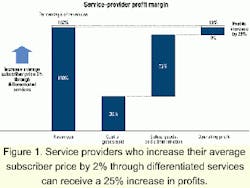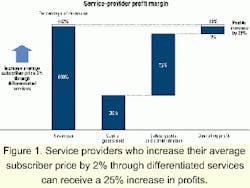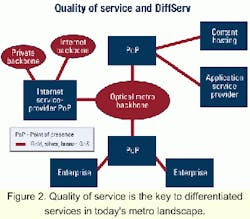QoS-based services boost profits and reduce churn
Choosing the right approach to quality of service is essential for carrier success.
BY ANDREW FELDMAN, Riverstone Networks
Bandwidth has become a commodity in today's metropolitan-networking marketplace. With the growing fiber transport systems and emerging services like Gigabit Ethernet, providers are rising to the challenge of delivering more bandwidth to more customers. The trouble is that bandwidth alone won't recoup the costs of network build-outs for these providers. Recent competitive local-exchange carrier (CLEC) and service-provider financial troubles prove that there's more to sustained profitability than delivering bigger pipes to more people.
With their costs growing at roughly 40% per year and revenues growing only at 20% per year, service providers must find ways to differentiate their offerings, increase revenues to existing customers, and reduce customer turnover (or churn).
For the foreseeable future, the key to sustained provider profitability will be high-value, differentiated services. From basic e-mail and remote access to videoconferencing, hosted applications, and virtual private networks (VPNs), the growing array of networking applications demands that providers offer tiered levels of service so their customers can buy the right level of service for each application.
To deliver these services, service providers need highly granular control over the quality of service (QoS) they deliver to each customer or application, and they must be able to achieve that control over the mix of ATM, SONET/SDH, WDM, Internet Protocol (IP), and legacy time-division multiplexing (TDM) networks that deliver services in metro markets.
Offering scalable differentiated voice and data services helps service providers improve profitability and increase customer satisfaction in several ways:
- Tailored service levels demonstrate to customers that the provider fully understands the range of their business networking needs, allowing providers to offer cost-optimized services for each of these needs.
- Customized network services reduce customer churn because, with each tailored service, the barrier to change becomes higher.
- Offering differentiated services increases revenue per subscriber by specifically targeting a range of specific needs. Studies show that increasing an existing subscriber's revenue by just 2% results in an increase of 25% to the provider's bottom line (see Figure 1).
- Tailoring services by customer or application improves overall bandwidth management in the service provider's network and helps eliminate "stranded bandwidth" that goes unused. For example, in the case of a customer that pays for a single T3 line but usually uses only half the 45 Mbits/sec of bandwidth, the provider could sell lower levels of bandwidth, except at peak usage times, then sell the saved bandwidth to other customers.
- Tailored services magnify the potential for add-on services by making both the provider and its customer more aware of specific networking needs and how they might be improved. For example, by monitoring a customer's data service closely, the provider can alert the customer when it is about to exceed its contract bandwidth level, then offer more bandwidth before the ceiling becomes an operational problem.
Service providers need to remember that they cannot tailor services until they can account for them in an efficient manner. QoS helps give providers the necessary tools to differentiate services.
QoS is the key to offering differentiated services, allowing providers to deliver specific, guaranteed levels of bandwidth to individual customers or applications. Today's applications range from high-bandwidth file transfers to interactive, low-bandwidth, low-latency "chat" applications and real-time applications like multimedia and IP telephony that require predictable delay characteristics from the network. IP telephony, known as voice over IP (VoIP), is a major component of the new "converged" data-network infrastructure that promises a new set of applications and services. With QoS, service providers can assign each of these applications a different traffic class (see Figure 2).SONET/SDH and ATM networks have claimed QoS as their primary advantage in the past, but neither offers the granular levels of service delivery that providers need to serve a varied metro customer base. As a result, IP and Ethernet are emerging as a more scalable, cost-effective networking method, and new protocols such as Multiprotocol Label Switching (MPLS) are now evolving that can provide the same levels of QoS for IP networks as ATM and SONET/SDH have offered in the past. These newer technologies also give service providers greater flexibility for remote provisioning and shorter provisioning times.
Service providers will use QoS mechanisms to slice bandwidth into customer-selected increments, then dynamically allocate that bandwidth on customer request. They can then offer service-level agreements (SLAs) that guarantee specific bandwidth levels for specific services. To do so, providers must be able to monitor bandwidth usage to ensure customers are getting what they paid for, reliably account and bill for these allocations in real time, and alert customers when their allotted bandwidth limit is no longer adequate.
Application- and customer-specific QoS benefits every type of customer in the metro market. For the storage service provider offering backup services to an application service provider (ASP) or collocation provider, high-bandwidth file transfers must occur at regularly scheduled times, and these transfers must be fast and reliable. Providers can use QoS to ensure sufficient band width is available at specified intervals, so ASPs can complete their backups without having to pay for such bandwidth levels all the time.
ASPs and collocation providers are faced with similar network challenges. As they offer services to enterprise customers, network delays are unacceptable. Access to application data must be assigned the highest priority across the network. While still important, e-mail or Web surfing can receive a somewhat lower priority to ensure that mission-critical data arrives with little delay. Even if you're a voice or video provider offering services to a building local-exchange carrier, the ability to assign priorities to delay- and jitter-sensitive content helps ensure that end users have a quality viewing or listening experience.In the raw bandwidth model of the past, providers used best-effort QoS. Network operations were limited to providing SLAs based solely on general availability through the infrastructure and not on how well applications performed within the infrastructure. Today, service-provider networks can carry a variety of traffic with service expectations that vary from application to application. Network elements and management software must provide the ability to guarantee bandwidth as well as manage delay characteristics (latency and jitter) by class or flow of traffic. Essentially, customers need different paths for different traffic, based on assigned priority.
For every instance of QoS, SLAs can be used as a contractual mechanism to ensure that network reliability and performance match expenditures. But in a market where metropolitan networks are and will be a mixture of SONET/ SDH, WDM, ATM, and IP traffic for some time to come, carriers must implement network infrastructures that allow them to cost-effectively deliver QoS-based services across all network types.
Service providers require advanced capabilities to support the services delivered over the metro network. Content and application hosting requires intelligent caching, load distribution, and secure partitioning without loss of performance. At the same time, Internet service providers need dynamic self-provisioning to reduce operating costs and maintain customer satisfaction. The infrastructure must allow partitioning for security to protect customer data, reliability to route around failures, and scalability to maintain return on investment throughout hectic subscriber acquisition and growth cycles.
There are a variety of technical approaches to achieving QoS across different network types. Traditionally, ATM was the only protocol that could ensure QoS, although ATM's higher cost was an obstacle to most users. Today, there are many options in use in the metro market, each one giving service providers varying levels of remote provisioning capabilities and time-to-market.
Dedicated wavelengths. With all-optical networks, service providers can offer QoS through dedicated wavelengths. Each customer receives one or more wavelengths using WDM. WDM technology allows more efficient use of existing fiber by simultaneously transmitting multiple wavelengths over a single fiber. Most metro areas have an existing fiber infrastructure, which turns the implementation of a WDM solution into an upgrade of existing deployments (more specifically, replacing SONET/SDH signaling equipment).
Separate wavelengths provide dedicated pipes for end users. For the bandwidth-intensive enterprise, service providers can assign multiple wavelengths for voice, video, and data. Traffic across the network would be separated and forwarded based on wavelength. For example, video could be assigned a higher priority than voice or data to minimize delay and jitter.
But wavelength-based traffic classification lacks the granular control that most providers need. At a minimum, pro viders would assign each customer a wavelength. With a finite number of wavelengths available in an optical network, wavelength-based traffic classification is unable to scale for millions of intended customers. And dedicated wavelengths must still be converted to electrical signals for the end user.
Private virtual circuits. Another more common approach to QoS is using private virtual circuits (PVCs) to carve out bandwidth within a network. PVCs are end-to-end, bidirectional channels that provide the look and feel of a private-line network without the need for dedicated bandwidth.
Each PVC is defined by a QoS based on the Committed Information Rate (CIR), which determines the available bandwidth between the two end points connected via a PVC. VPNs created with PVCs have been in existence since networking began. The first VPNs were created with leased lines to provide privacy for interchange of sensitive information and resource protection of information assets.
Later VPNs came with frame relay and ATM PVCs, designed to replace very expensive private lines by increasing the reliability and security of business traffic over shared carrier backbones. Frame relay is more appropriate for "burstable" data applications than for those requiring a constant data stream. Similar to using frame relay, an ATM-based VPN is established between two ATM nodes. A service provider selects QoS based on the customer application and latency requirements. For example, voice traffic would be routed to a constant-bit-rate PVC, while bursty transactional traffic will be routed to variable-bit-rate PVC and large non-critical files would be transferred over unavailable bit rate (or best-effort-type service). Service pro viders sometimes refer to different QoS plans as "gold," "silver," and "bronze." The customer can choose what level best balances speed with cost.
IP routing. Across every network, data finds its way from one host computer to another using routing technology. The first and most basic job of the router is to know where to send information. Congestion-management tools help packets ride over bursts of traffic in the network without undue loss of data. When the router is receiving more traffic than it has the physical capacity to process, it buffers the data until it can be processed. The bigger the data buffer, the better the chances that no traffic will get lost during congested times.
WDM-based optical networks are becoming the core networks of the Internet transport infrastructure because of the plentiful bandwidth capacity they offer and their potential for real-time provisioning of bandwidth on demand. Routers with optical-electrical crossconnects convert signals from optical to electrical and back again to optical (OEO conversion). OEO conversion is especially important at the edge of the network domain for providers to offer differentiated services using QoS, because full networking of an optical signal requires optical memory, which isn't perfected.
IP-routed networks have grown in importance and are quickly becoming the network of the future. Technology now exists to provide IP-"routed" VPNs. Network-based VPNs incorporate a combination of necessary services, including an application proxy firewall, encryption, key management, bandwidth management, intrusion detection, and tunnel termination. IP VPNs rely on protocols such as IPSec, L2TP, and MPLS. As data is encapsulated and moved across shared lines, VPN services provide the end user with necessary QoS.
With IP routing, service providers can also offer point-to-point and point-to-multipoint connections using virtual-leased-line (VLL) and transparent LAN services (TLS). However, as users and networks grow in number, VLL and TLS suffer from several scalability issues.
A new approach using MPLS-based VLL services addresses these scalability issues, enabling the service provider to offer a logical pipe formed by two MPLS label-switched paths (LSPs) going in opposite directions. These LSPs with specific QoS characteristics can be statically preconfigured or dynamically established using MPLS signaling protocols to meet specific traffic requirements. Service providers can extend the VLL model to offer TLS when more than two sites, such as enterprise branch offices, must be connected.
Each one of these solutions-dedicated wavelengths, PVCs, and IP routing-can be used to deliver prioritized traffic or QoS across the network. QoS meets the metro business model of serving any customer and providing any service, and providers must be prepared to deliver QoS to any customer for any service.
When purchasing equipment, pro viders must decide whether to perpetuate existing diverged networks that require separate switching equipment or choose routers that handle optical interfaces and manage bandwidth onto ATM or IP customer networks. QoS solutions that offer the most flexibility and control in the changing metropolitan market will be the most helpful in bringing service providers the success they seek in the metro environment.
Andrew Feldman is vice president of corporate marketing and corporate development at Riverstone Networks (Santa Clara, CA).


